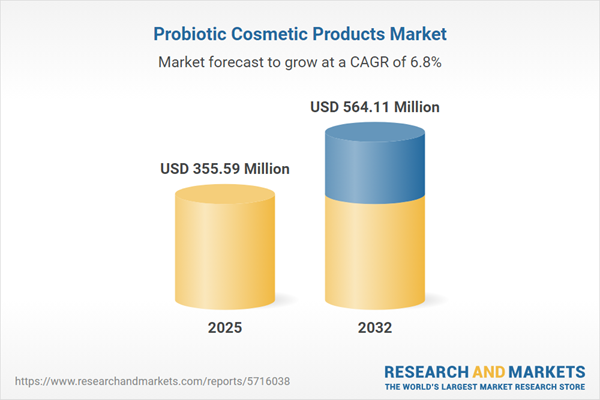Speak directly to the analyst to clarify any post sales queries you may have.
The probiotic cosmetic products market is redefining enterprise strategies as industry leaders adapt to dynamic consumer and regulatory shifts. Forward-looking organizations are prioritizing innovation, transparency, and operational agility to strengthen B2B relationships and secure growth opportunities within this evolving sector.
Market Snapshot: Probiotic Cosmetic Products Market Overview
In 2024, the probiotic cosmetic products market reached USD 332.85 million, with forecasts indicating an increase to USD 355.59 million by 2025 and a projected value of USD 564.11 million by 2032, reflecting a 6.81% CAGR. Market momentum is underpinned by rising demand for microbiome-focused skincare and elevated standards for scientific rigor in product development. Both multinational incumbents and agile challengers are accelerating portfolio diversification through partnerships, advancements in delivery methods, and technology-driven innovation. These trends illustrate a market-wide pivot toward enhanced transparency, reliable supply networks, and responsive cross-border enterprise engagement.
Scope & Segmentation: Strategic Foundations in the Probiotic Cosmetic Products Market
Understanding market segmentation empowers senior decision-makers to refine strategies and maximize operational effectiveness. Segment alignment enables organizations to adapt rapidly, ensuring resource allocation meets distinct buyer needs while uncovering targeted growth avenues in competitive environments.
- Product Types: Cleansers, creams, lotions, facial masks, serums, essences, and toners, each engineered for increased hydration, improved skin barrier strength, or textural enhancements.
- End User: Solutions designed for women, men, and unisex applications across face, body, and haircare, supporting precise positioning for varied business audiences.
- Application: Spanning body care routines, facial treatments, anti-aging, brightening, and hair or scalp-focused offerings, satisfying a range of operational and client objectives.
- Formulation: Incorporates fermented extracts, live probiotics, prebiotics, and postbiotics, delivering systematic solutions for efficacy and safety across product portfolios.
- Price Range: Covers economy to premium tiers, enabling adaptive go-to-market strategies and facilitating competitive channel differentiation.
- Gender: Supports both gender-specific and unisex solutions for versatile regional alignment and targeted messaging.
- Distribution Channel: Includes direct-to-consumer, e-commerce, pharmacies, specialty retail, and supermarkets, providing robust access that aligns with shifting commerce trends.
- Geographies: Asia shows strong expansion, particularly in China, India, Japan, Australia, and Southeast Asia, with strategic business development also active across the Americas, Europe, Middle East, and Africa through tailored channel strategies.
- Leading Companies: L’Oréal S.A., Unilever PLC, Estée Lauder Companies Inc., Procter & Gamble, Johnson & Johnson, Shiseido, Beiersdorf, Coty Inc., Kao Corporation, and Amorepacific drive competitive benchmarks and elevate technical standards.
Key Takeaways for Senior Decision-Makers
- Biotechnology-focused partnerships are accelerating innovative capabilities while streamlining quality compliance, increasing overall market competitiveness among industry stakeholders.
- Rapid adoption of artificial intelligence in diagnostics enhances product personalization and supports evidence-driven development, ensuring organizations can meet emerging B2B client expectations.
- Strengthening local and plant-based sourcing drives regulatory responsiveness, advances traceability, and builds stakeholder trust in supply chain operations and product integrity.
- Diversified pricing formats and multiple distribution channels increase resilience during market disruptions, enabling businesses to swiftly adapt their commercial models.
- Operational transparency and responsible procurement practices reinforce brand reputations and foster lasting B2B alliances, contributing to proactive regulatory navigation.
- The use of predictive analytics and real-time market data supports targeted innovation, giving companies an edge as they pursue emerging market opportunities at both regional and global levels.
Tariff Impact: Strategic Adjustments to 2025 Policy Changes
Recent United States tariff changes affecting key ingredients have led to higher input costs in the probiotic cosmetics sector. Industry leaders are strategically increasing domestic and regional sourcing, forging partnerships with botanical providers, and fortifying supply chain resilience. These measures sustain product continuity, promote ingredient advancements, and support pricing steadiness amid market volatility.
Methodology & Data Sources
This analysis integrates interviews with dermatology and chemistry experts, direct insights from market leaders, end-user surveys, and in-depth reviews of regulatory and patent data. Regional and application-based segmentation contextualizes findings for informed planning.
Why This Report Matters
- Facilitates proactive planning for compliance and regulatory evolution within a rapidly changing B2B landscape.
- Clarifies the operational impact of innovation and transparency, equipping decision-makers to drive productivity and improve collaboration across business functions.
- Guides strategic investment choices, allowing stakeholders to capitalize on emerging opportunities while managing the increasing complexity of global regulations.
Conclusion
Applying the strategic guidance in this report enhances organizational agility, positioning enterprise leaders to anticipate and respond effectively to shifts within the probiotic cosmetic products market.
Additional Product Information:
- Purchase of this report includes 1 year online access with quarterly updates.
- This report can be updated on request. Please contact our Customer Experience team using the Ask a Question widget on our website.
Table of Contents
3. Executive Summary
4. Market Overview
7. Cumulative Impact of Artificial Intelligence 2025
Companies Mentioned
The companies profiled in this Probiotic Cosmetic Products market report include:- L'Oréal S.A.
- Unilever PLC
- Estée Lauder Companies Inc.
- The Procter & Gamble Company
- Johnson & Johnson Consumer Inc.
- Shiseido Company, Limited
- Beiersdorf Aktiengesellschaft
- Coty Inc.
- Kao Corporation
- Amorepacific Corporation
Table Information
| Report Attribute | Details |
|---|---|
| No. of Pages | 192 |
| Published | October 2025 |
| Forecast Period | 2025 - 2032 |
| Estimated Market Value ( USD | $ 355.59 Million |
| Forecasted Market Value ( USD | $ 564.11 Million |
| Compound Annual Growth Rate | 6.8% |
| Regions Covered | Global |
| No. of Companies Mentioned | 11 |









